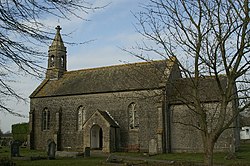Burtle
{{infobox UK place|
|country = England
|static_image =  |static_image_caption = St Philips & St James Church
|static_image_2 =
|static_image_caption = St Philips & St James Church
|static_image_2 =  |static_image_2_caption = Farmhouse, North of Burtle
|latitude= 51.17
|longitude=-02.87
|official_name =Burtle
|population =
|shire_district= [[Sedgemoor]
| shire_county = Somerset
|region= South West England
|constituency_westminster= Wells
|post_town= Bridgwater
|postcode_district= TA7
|postcode_area=TA
|dial_code= 01278
|os_grid_reference= ST3942
}}
Burtle is a village and civil parish on the Somerset Levels in the [[Sedgemoor] district of Somerset, England.
|static_image_2_caption = Farmhouse, North of Burtle
|latitude= 51.17
|longitude=-02.87
|official_name =Burtle
|population =
|shire_district= [[Sedgemoor]
| shire_county = Somerset
|region= South West England
|constituency_westminster= Wells
|post_town= Bridgwater
|postcode_district= TA7
|postcode_area=TA
|dial_code= 01278
|os_grid_reference= ST3942
}}
Burtle is a village and civil parish on the Somerset Levels in the [[Sedgemoor] district of Somerset, England.
History
Burtle Priory (also known as Burtle Moor Priory) originated as a hermitage on a site called Sprauellissmede, endowed by William son of Godfrey of Eddington in 1199. It was later known as St Stephens chapel and by 1312 a house of the Augustinian Canons Regular.[1]
It is close to the village of Edington and between them was Edington Burtle station on a branch of the Somerset and Dorset Joint Railway, which opened in 1890 and closed on March 7, 1966.
Governance
The parish council has responsibility for local issues, including setting an annual precept (local rate) to cover the council’s operating costs and producing annual accounts for public scrutiny. The parish council evaluates local planning applications and works with the local police, district council officers, and neighbourhood watch groups on matters of crime, security, and traffic. The parish council's role also includes initiating projects for the maintenance and repair of parish facilities, as well as consulting with the district council on the maintenance, repair, and improvement of highways, drainage, footpaths, public transport, and street cleaning. Conservation matters (including trees and listed buildings) and environmental issues are also the responsibility of the council.
The village falls within the Non-metropolitan district of Sedgemoor, which was formed on April 1, 1974 under the Local Government Act 1972, having previously been part of Bridgwater Rural District,[2] who are responsible for local planning and building control, local roads, council housing, environmental health, markets and fairs, refuse collection and recycling, cemeteries and crematoria, leisure services, parks, and tourism.
Somerset County Council are responsible for running the largest and most expensive local services such as education, social services, libraries, main roads, public transport, policing and fire services, trading standards, waste disposal and strategic planning.
It is also part of the Wells county constituency represented in the House of Commons of the Parliament of the United Kingdom. It elects one Member of Parliament (MP) by the first past the post system of election, and part of the South West England constituency of the European Parliament which elects seven MEPs using the d'Hondt method of party-list proportional representation.
Religious sites
The Anglican Church of St Philip and St James was built in 1838-9 by Richard Carver, the County Architect and Surveyor.[3]
References
- ^ Bush, Robin (1994). Somerset: The complete guide. Wimborne, Dorset: Dovecote Press. pp. pp 54. ISBN 1874336261.
{{cite book}}:|pages=has extra text (help); Cite has empty unknown parameter:|coauthors=(help) - ^ A Vision of Britain Through Time : Bridgwater Rural District
- ^ "Church of St Philip and St James". Images of England. English Heritage. Retrieved 23 November 2008.
